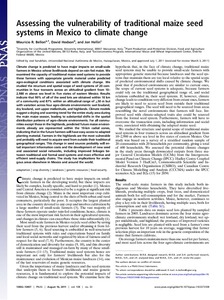Despite decades of attention by conservationists, deforestation remains a critical problem in Latin America, particularly in agricultural frontiers like the Amazon and the lowlands of Central America. The limited impact of conservation initiatives in such regions stems partly from a poor…
Consulting services for the identification of actors and studies on knowledge, attitudes and practices for the purpose of preparing a map of stakeholders and relationships between them in three selected basins.
BACKGROUND: South America is one of the most species diverse continents in the world. Within South America diversity is not distributed evenly at both local and continental scales and this has led to the recognition of various areas with unique species assemblages. Several schemes currently…
The introduction to this set of papers highlights four challenges to the large-scale analysis of population growth at protected area edges in Africa and Latin America undertaken by George Wittemyer and colleagues in their 2008 paper published in Science. First, it raises questions about their…
It is widely accepted that natural resources should only be sustainably exploited and utilized to effectively preserve our planet for future generations. To better manage the natural resources, and to better understand the closely linked Earth systems, the concept of Digital Earth has been…
Mediterranean ecosystems are global hotspots of biodiversity threaten by human disturbances. Growing evidence indicates that regeneration of Mediterranean forests can be halted under certain circumstances and that successional stages can become notoriously persistent. The Mediterranean…
Two species of flowering plant of Fuegian montane provenance have been discovered on Deception Island in the maritime Antarctic, 950 km south of South America. Four individuals of Nassauvia magellanica and one of Gamochaeta nivalis (both Asteraceae) are growing robustly and in close proximity of…
We used the process-oriented niche model CLIMEX to estimate the potential global distribution of serrated tussock under projected future climates. Serrated tussock is a drought-tolerant, wind- and human-dispersed grass of South American origin that has invaded pastures in Australia, Europe, New…
Climate change is predicted to have major impacts on small-scale farmers in Mexico whose livelihoods depend on rain-fed maize. We examined the capacity of traditional maize seed systems to provide these farmers with appropriate genetic material under predicted agro-ecological conditions…
A central challenge for effective watershed
management is improving the welfare of residents who
live in upper catchments while providing adequate
environmental goods and services to people and
areas downstream. A CPWF project, Sustaining
Collective Action Linking…






